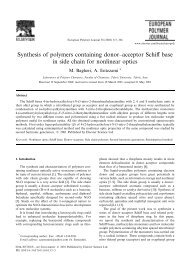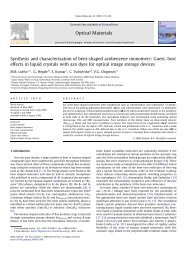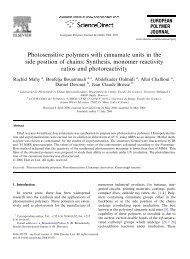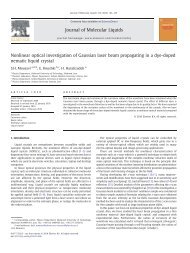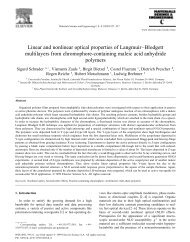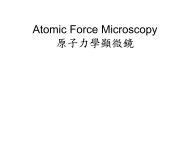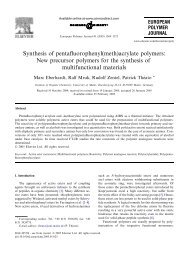Synthesis and characterization of cyclohexene oxide functional ...
Synthesis and characterization of cyclohexene oxide functional ...
Synthesis and characterization of cyclohexene oxide functional ...
Create successful ePaper yourself
Turn your PDF publications into a flip-book with our unique Google optimized e-Paper software.
cationic species are quite reactive towards these groups. In this<br />
article, we present the results <strong>of</strong> a study <strong>of</strong> the preparation <strong>of</strong><br />
CHO end-<strong>functional</strong> macromonomers via ATRP <strong>of</strong> styrene monomer<br />
using a new CHO-<strong>functional</strong> initiator <strong>and</strong> a Cu(I)Br/bipyridine<br />
catalyst system.<br />
2. Experimental<br />
2.1. Materials<br />
Styrene (St) (Fluka) <strong>and</strong> <strong>cyclohexene</strong> <strong>oxide</strong> (CHO) (Aldrich)<br />
were distilled over calcium hydride (CaH 2) <strong>and</strong> stored in a refrigerator<br />
under nitrogen before use. The compounds 3-<strong>cyclohexene</strong>-1methanol<br />
(Aldrich), 2-bromopropanoyl bromide (Aldrich),<br />
3-chloroperoxybenzoic acid (Aldrich), <strong>and</strong> sodium bicarbonate<br />
(NaHCO 3) (Merck) were used as received. The compound 2,2-dimethoxy-2-phenyl<br />
acetophenone (DMPA) (Irgacure 651), the photoinitiator,<br />
was purchased from Ciba Specialty Chemicals <strong>and</strong> used<br />
as received without further purification. Dichloromethane (CH2Cl2)<br />
(Lab-scan) pyridine (Lab-scan), diphenyliodonium hexafluorophosphate<br />
(Ph2I + PF 6 ) (Fluka), CuBr (Aldrich), 2,2 0 -bipyridine (Merck)<br />
<strong>and</strong> all other solvents <strong>and</strong> chemicals were used as received.<br />
2.2. <strong>Synthesis</strong> <strong>of</strong> 3-cyclohexenylmethyl-2-bromopropanoate (CH–Br)<br />
For this synthesis, 3-<strong>cyclohexene</strong>-1-methanol (5.02 mL,<br />
44.6 mmol), pyridine (5.40 mL, 66.9 mmol), <strong>and</strong> 30 mL dry CH2Cl2<br />
were added to a two-necked round-bottom flask fitted with a magnetic<br />
stirrer, nitrogen inlet–outlet <strong>and</strong> an addition funnel containing<br />
2-bromopropanoyl bromide (7.07 mL, 66.90 mmol) <strong>and</strong> 5 mL<br />
dry CH2Cl2. The flask was placed in an ice-water bath. The solution<br />
<strong>of</strong> 2-bromopropanoyl bromide was added dropwise over a period<br />
<strong>of</strong> 1 h under nitrogen. The mixture was stirred at 0 °C for 30 min.<br />
The mixture was then allowed to reach room temperature <strong>and</strong> stirred<br />
at that temperature overnight. The solution was washed with<br />
0.2 N HCl <strong>and</strong> several times with water. Finally, the solution was<br />
dried with MgSO4, <strong>and</strong> the solvent was removed by vacuum distillation.<br />
A yellowish liquid product was obtained. Yield: 9.97 g, 91%.<br />
C10H15O2Br: (247,131): Calcd. C, 48.60%; H, 6.07%, Found: C,<br />
48.12%; H, 6.01%. 1 H NMR (acetone-d 6, d/ppm): 5.92–5.52 (m, 2H,<br />
HC@CH), 4.75–4.41 (q, 1H, CH–Br), 4.28–3.82 (m, 2H, OCH2),<br />
2.16–1.96 (m, 1H, OCH 2CH), 1.84–1.65 (d, 3H, CH 3CH), 1.51–1.16<br />
(m, 6H, methylene protons <strong>of</strong> <strong>cyclohexene</strong> <strong>oxide</strong> group). FT-IR<br />
Table 1<br />
<strong>Synthesis</strong> <strong>of</strong> CHO end-<strong>functional</strong> macromonomers <strong>of</strong> PSt by ATRP a using CHO–Br as initiator.<br />
(cm 1 ): 3024 (C@C–H stretch), 1739 (C@O ester b<strong>and</strong>), 1651 (C@C<br />
stretch).<br />
2.3. <strong>Synthesis</strong> <strong>of</strong> <strong>cyclohexene</strong> <strong>oxide</strong> (CHO) <strong>functional</strong> ATRP initiator<br />
(CHO–Br)<br />
Epoxidation <strong>of</strong> the 3-cyclohexenylmethyl-2-bromopropanoate<br />
was performed under inert atmosphere at 0 °C. The obtained 3cyclohexenylmethyl-2-bromopropanoate<br />
(4 g, 16.18 mmol), sodiumbicarbonate<br />
(5.437 g, 64.72 mmol), 3-chloroperoxybenzoic acid<br />
(5.58 g, 32.37 mmol) <strong>and</strong> 20 mL <strong>of</strong> dry CH 2Cl 2 were added into a<br />
100-mL three-necked round-bottom flask fitted with a condenser,<br />
a magnetic stirrer, <strong>and</strong> a nitrogen inlet–outlet. The flask was placed<br />
in an ice-water bath <strong>and</strong> stirred for 30 min. Then, the mixture was<br />
allowed to reach room temperature <strong>and</strong> stirred at that temperature<br />
for 2 h. After the reaction, the reaction mixture was added into<br />
100 mL <strong>of</strong> water, <strong>and</strong> then extracted several times with CH 2Cl 2. Finally,<br />
the solution was dried with MgSO4, <strong>and</strong> the solvent was removed<br />
by vacuum distillation. A yellowish oily product was<br />
obtained. Yield: 2.25 g, 53%.<br />
C 10H 15O 3Br: (263,130): Calcd. C, 45.64%; H, 5.70%, Found: C,<br />
45.12%; H, 5.54%. 1 H NMR (acetone-d6, d/ppm): 4.73–4.42 (q, 1H,<br />
CH–Br), 4.41–3.86 (m, 2H, OCH 2), 3.23–3.00 (m, 2H, CH–O–CH,<br />
ep<strong>oxide</strong> protons), 2.24–1.94 (m, 1H, OCH2CH), 1.82–1.62 (d, 3H,<br />
CH 3CH), 1.60–1.00 (m, 6H, methylene protons <strong>of</strong> <strong>cyclohexene</strong> <strong>oxide</strong><br />
group). FT-IR (cm 1 ): 1739 (C@O ester b<strong>and</strong>), 920 (ep<strong>oxide</strong> b<strong>and</strong>),<br />
2.4. <strong>Synthesis</strong> <strong>of</strong> <strong>cyclohexene</strong> <strong>oxide</strong> end-<strong>functional</strong> macromonomer <strong>of</strong><br />
polystyrene by atom transfer radical polymerization (CHO-PSt)<br />
A Schlenk tube equipped with a magnetic stirrer was used. The<br />
system was vacuumed <strong>and</strong> back-filled with nitrogen several times.<br />
The catalyst (CuBr), lig<strong>and</strong> bipyridine (bpy), initiator (CHO–Br), <strong>and</strong><br />
monomer (St) were introduced under inert atmosphere. The tube<br />
was placed in an oil bath warmed at 110 °C <strong>and</strong> stirred at that temperature.<br />
After a given time (see Table 1), the mixture was diluted<br />
with THF <strong>and</strong> poured into ten-fold methanol. The macromonomer<br />
(CHO-PSt) was collected after filtration <strong>and</strong> dried at 40 °C in vacuum<br />
overnight. In order to remove the complex salt from the polymer,<br />
it was redissolved in THF <strong>and</strong> passed through an alumina<br />
column, followed by precipitation in methanol.<br />
1 H NMR (acetone-d6, d/ppm): 7.52–6.39 (m, 5H, Ar–H), 4.60 (q,<br />
1H, CH–Br), 3.84–3.63 (m, 2H, OCH2), 3.23–3.00 (m, 2H, CH–O–CH,<br />
Run [I] 10 2 (mol L 1 ) Time (min) Conversion (%) Mn theo<br />
b<br />
Mn GPC Mw/Mn 1 9.7 180 45 4500 3650 1.21 4200<br />
2 28.9 90 39 1490 1590 1.27 1920<br />
3 57.9 60 59 1160 970 1.24 1025<br />
a<br />
Temperature 110 °C, [St]0 = 8.75 mol L 1 (in bulk), [I]:[CuBr]:[Bpy] = 1:1:3.<br />
b<br />
Determined by GPC according to PSt st<strong>and</strong>ards.<br />
Table 2<br />
Photoinitiated cationic polymerization <strong>of</strong> CHO-PSt macromonomer a .<br />
M n H NMR<br />
Run Photoinitiaton type Activator (mol L 1 ) Wavelength (k, nm) Mn Mw/Mn 1 Direct – 300 3940 1.60<br />
2 Promoted DMPA (5810 –3 ) 350 4110 1.44<br />
3 Sensitized Anthracene (5 10 3 ) 350 6200 1.75<br />
Conversions were calculated using the following formula: Conv.% = (W – W 0)/W 100 ; where W <strong>and</strong> W 0 are the total polymer obtained <strong>and</strong> unreacted macromonomer.<br />
a Macromonomer: 200 g L 1 with Mn = 1590; onium salt, Ph 2I + PF 6 :5 10 3 mol L 1 ; temperature: room temperature; solvent: CH 2Cl 2; irradiation time: 5 h; conversions:<br />
>99%.<br />
M. Degirmenci et al. / Reactive & Functional Polymers 70 (2010) 28–34 29



